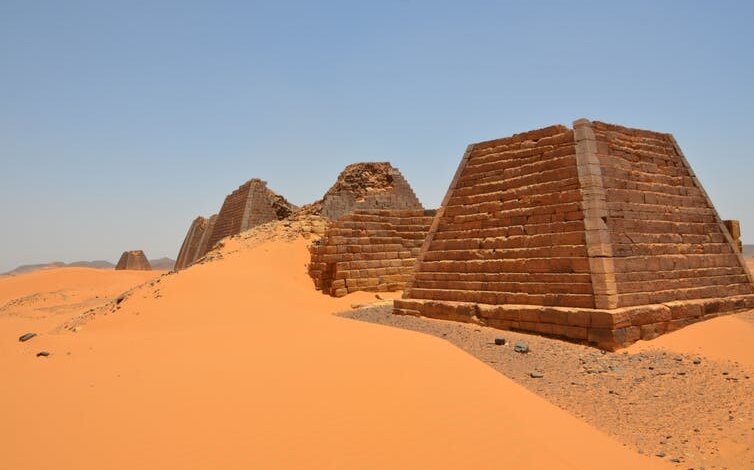Sudan’s Forgotten Pyramids are more than Egypt’s

The term “pyramid” is commonly associated with Egypt, although the world’s largest collection of these magnificent ancient buildings is found in Sudan, the Land of Kush. Kush was tied to the historical Cush, son of Ham and grandson of Noah, whose ancestors lived in northeast Africa, according to various religious traditions.
The land overwhelms with more pyramids than its neighbouring countries. A majestic view emerges from beyond the horizon as you drive north from Khartoum along a short desert road toward the ancient city of Meroe: dozens of high pyramids piercing the horizon. There is an amazed sense of discovery no matter how many times you visit. The route splits Meroe, which was originally the capital of the Kingdom of Kush.
Sudan’s ancient Nubian civilisation left behind more than 220 pyramids, as well as temples, tombs, and royal burial chambers, that rise out of the desert at three archaeological sites: El Kurru, Jebel Barkal, and Meroe. They range in height from 20 to 30 meters and have steep sides.
The Nubian pyramids are just as beautiful and culturally significant as the famed Egyptian pyramids of Giza. Intrepid tourists can even enjoy a crowd-free experience. The steeply sloping pyramids are made of sandstone and granite and contain altars and interment chambers decorated with imagery and inscriptions carved in hieroglyphs and Meroitic script, commemorating the rulers’ lives in Meroe, a wealthy Nile city and the seat of power of Kush, an ancient kingdom and rival to Egypt.
Click here for various photos of Sudan’s Pyramids
The ancient world beyond the first cataract of the Nile, named Sudan Ta-Seti, or Land of the Bow, because the inhabitants were expert archers; Ta-Nehesi, or Land of Copper; Ethiopia, or Land of Burnt Faces, from the Greek; Nubia, possibly derived from an ancient Egyptian word for gold, which was abundant; and Kush, the kingdom that dominated the region between roughly 2500 B.C. and A.D. 300. Meroe, a cultural gem some 220 kilometers north of Khartoum, is today one of Sudan’s most valuable Unesco world heritage sites.
However, the monuments have suffered as a result of a lack of preservation, weather extremes, and looters. Italian adventurer Giuseppe Ferlini in his pursuit for Kushite riches in the 1880s, blew up many pyramids, leaving many of the tombs without their pyramidal tops. Many more of Sudan’s pyramids were ransacked and destroyed as a result of the plundering.
He leveled the pyramid N6 of the Kandake Amanishakheto at Wad ban Naqa, starting at the top, and discovered later her wealth, which consisted of dozens of gold and silver jewelry items. He is thought to be responsible for the demolition of around 40 pyramids in total.
Ferlini returned home in 1836 after discovering the wealth he was hunting for. He prepared a report of his journey a year later, which included a list of his finds and was translated into French and republished in 1838.
He attempted to sell the treasure, but no one thought that such high-quality jewelry could be produced in Sub-Saharan Africa at the time. His findings were eventually sold in Germany: part of them were purchased by King Ludwig I of Bavaria and are now in the State Museum of Egyptian Art in Munich, while the remainder was purchased by the Egyptian Museum in Berlin, where it is still today, on the advice of Karl Richard Lepsius and Christian Charles Josias von Bunsen.
However, at the heart of the Sudanese deserts where the civilisation once flourished, sandstorms and shifting sand dunes have always been the major threats to the region’s ancient heritage sites. The climate change has compounded the issue by making the region more drier and causing more frequent sandstorms. In rural Sudan, shifting sands can envelop entire villages and cover crops, irrigation channels, and riverbanks.
In many experts’ viewpoint, increased vegetation cover is the most effective technique to fight sand migration and desertification in the region. These are World Heritage sites, and Africa cannot afford to lose it to the deserts.
Source: News Agencies
Abeeb Lekan Sodiq is a Managing Editor & Writer at theafricandream.net. He’s as well a Graphics Designer and also known as Arakunrin Lekan.





